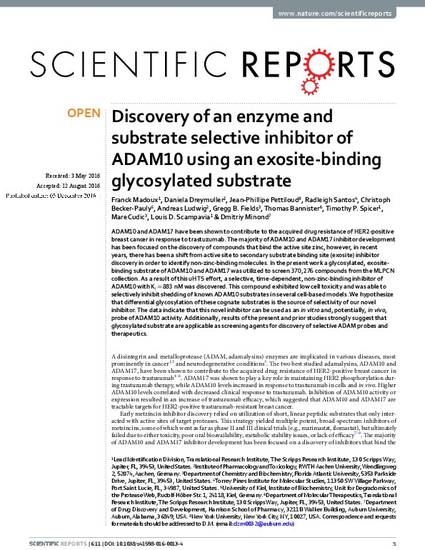
- Drug Development,
- Molecular Medicine
ADAM10 and ADAM17 have been shown to contribute to the acquired drug resistance of HER2-positive breast cancer in response to trastuzumab. The majority of ADAM10 and ADAM17 inhibitor development has been focused on the discovery of compounds that bind the active site zinc, however, in recent years, there has been a shift from active site to secondary substrate binding site (exosite) inhibitor discovery in order to identify non-zinc-binding molecules. In the present work a glycosylated, exosite-binding substrate of ADAM10 and ADAM17 was utilized to screen 370,276 compounds from the MLPCN collection. As a result of this uHTS effort, a selective, time-dependent, non-zinc-binding inhibitor of ADAM10 with Ki = 883 nM was discovered. This compound exhibited low cell toxicity and was able to selectively inhibit shedding of known ADAM10 substrates in several cell-based models. We hypothesize that differential glycosylation of these cognate substrates is the source of selectivity of our novel inhibitor. The data indicate that this novel inhibitor can be used as an in vitro and, potentially, in vivo, probe of ADAM10 activity. Additionally, results of the present and prior studies strongly suggest that glycosylated substrate are applicable as screening agents for discovery of selective ADAM probes and therapeutics.
Available at: http://works.bepress.com/radleigh-santos/19/

This work is licensed under a Creative Commons Attribution 4.0 International License. The images or other third party material in this article are included in the article’s Creative Commons license, unless indicated otherwise in the credit line; if the material is not included under the Creative Commons license, users will need to obtain permission from the license holder to reproduce the material. To view a copy of this license, visit http://creativecommons.org/licenses/by/4.0/